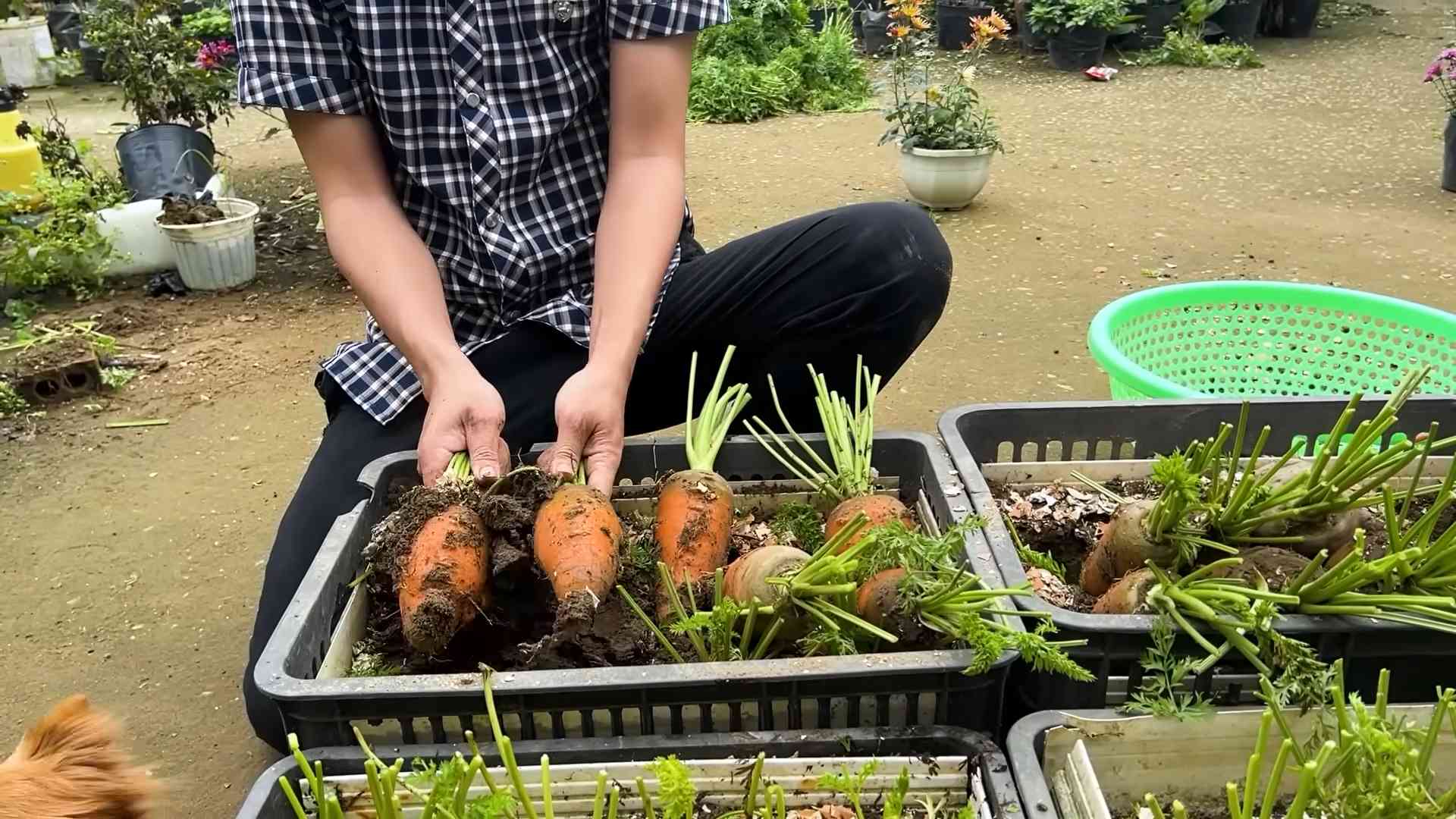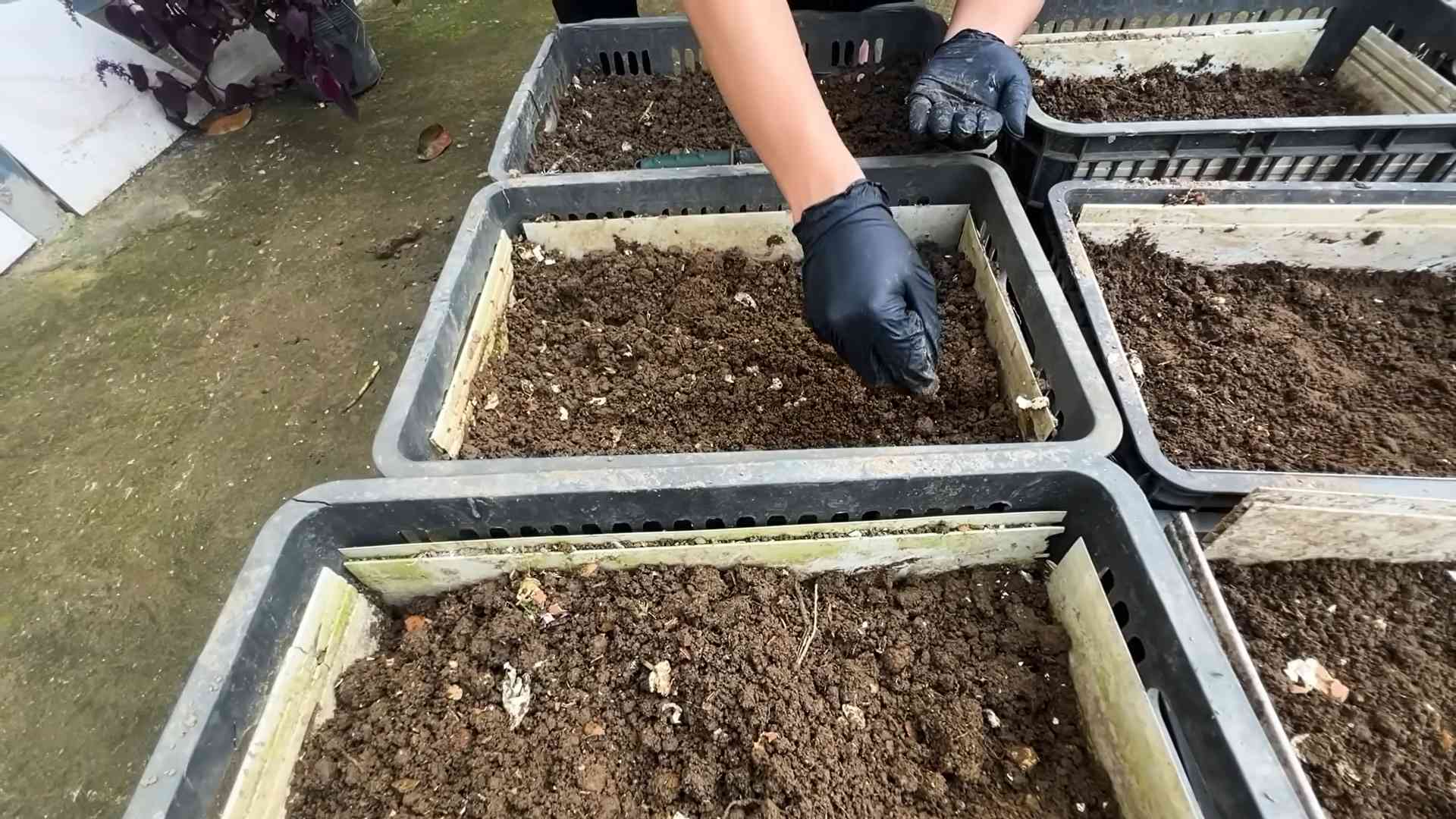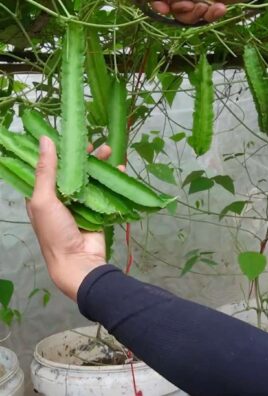Growing Carrots Indoors might sound like a whimsical dream reserved for seasoned gardeners, but trust me, it’s totally achievable, even for beginners like you and me! Forget battling unpredictable weather and pesky garden critters – imagine plucking fresh, sweet carrots right from your windowsill, any time of year.
For centuries, humans have cultivated carrots, tracing their origins back to Afghanistan. While traditionally an outdoor crop, the desire for year-round access to fresh produce has fueled innovative techniques like indoor gardening. Think about it: no more trips to the grocery store for bland, pre-packaged carrots. You can have vibrant, flavorful carrots, bursting with nutrients, grown with your own two hands!
This DIY guide is your passport to a thriving indoor carrot patch. We’ll unlock the secrets to selecting the right varieties, creating the perfect growing environment, and troubleshooting common issues. Whether you’re short on space, live in an apartment, or simply crave the satisfaction of nurturing your own food, growing carrots indoors is a rewarding and surprisingly simple project. So, grab your pots, soil, and seeds, and let’s embark on this exciting gardening adventure together! I’m excited to share these tips and tricks with you!

Growing Carrots Indoors: A Step-by-Step Guide
Hey there, fellow gardening enthusiasts! Ever dreamt of enjoying fresh, homegrown carrots even when the weather outside is frightful? Well, dream no more! I’m going to walk you through the surprisingly simple process of growing carrots indoors. It’s a fun and rewarding project, and trust me, the taste of those homegrown carrots is unbeatable.
Choosing the Right Carrot Variety
Before we dive in, it’s important to pick the right carrot variety. Not all carrots are created equal, especially when it comes to indoor growing. We want to choose varieties that are shorter and more compact.
* Consider these varieties: ‘Thumbelina,’ ‘Paris Market,’ ‘Little Finger,’ or ‘Short n Sweet.’ These are all round or shorter varieties that won’t need a ton of depth to grow.
* Why shorter varieties? Because deep containers can be a pain, and these little guys are perfectly happy in shallower pots. Plus, they mature faster!
Gathering Your Supplies
Okay, let’s get our hands dirty (figuratively, for now!). Here’s what you’ll need to get started:
* Containers: Choose containers that are at least 8-12 inches deep. Remember, carrots need room to grow downwards. I prefer using plastic pots because they’re lightweight and easy to move around, but terracotta pots work too, just be mindful of the extra weight.
* Potting Mix: This is crucial! Don’t just grab any old soil from your backyard. Carrots need loose, well-draining soil. I recommend a mix of peat moss, perlite, and vermiculite. You can also buy a pre-made potting mix specifically designed for vegetables.
* Carrot Seeds: Obviously! Make sure you get fresh seeds from a reputable source. Check the expiration date on the packet.
* Watering Can or Spray Bottle: For gentle watering.
* Grow Lights (Optional but Recommended): If you don’t have a super sunny spot, grow lights will be your best friend.
* Fertilizer (Optional): A balanced liquid fertilizer can give your carrots a boost.
Planting Your Carrot Seeds
Alright, time to get planting! This is where the magic begins.
1. Prepare the Soil: Fill your containers with the potting mix, leaving about an inch of space at the top. Gently pat the soil down to remove any large air pockets.
2. Sow the Seeds: Carrot seeds are tiny, so be careful! Sprinkle the seeds evenly over the surface of the soil. I like to aim for about 2-3 seeds per inch. Don’t worry about being perfect; we’ll thin them out later.
3. Cover the Seeds: Lightly cover the seeds with about ¼ inch of soil. You can use your fingers or a small trowel.
4. Water Gently: Use your watering can or spray bottle to gently moisten the soil. Be careful not to wash the seeds away. The soil should be damp, but not soggy.
5. Label Your Containers: Don’t forget to label your containers with the date and the variety of carrots you planted. It’s easy to forget later on!
Caring for Your Indoor Carrots
Now that your seeds are planted, it’s time to nurture them. This is where patience comes in.
1. Maintain Consistent Moisture: Keep the soil consistently moist, but not waterlogged. Check the soil moisture daily by sticking your finger about an inch into the soil. If it feels dry, water it.
2. Provide Adequate Light: Carrots need at least 6-8 hours of sunlight per day. If you don’t have a sunny window, use grow lights. Position the grow lights a few inches above the seedlings.
3. Thin the Seedlings: Once the seedlings are about 2 inches tall, it’s time to thin them out. This means removing some of the seedlings so that the remaining ones have enough space to grow. Snip off the weaker seedlings at the soil line, leaving about 1-2 inches between each plant.
4. Fertilize (Optional): If you choose to fertilize, do so every 2-3 weeks with a balanced liquid fertilizer diluted to half strength. Follow the instructions on the fertilizer label.
5. Rotate the Containers: If you’re using natural sunlight, rotate the containers regularly to ensure that all sides of the plants receive equal light. This will help them grow evenly.
Dealing with Common Problems
Even with the best care, you might encounter a few problems along the way. Don’t worry, I’ve got you covered!
* Poor Germination: If your seeds aren’t germinating, it could be due to several factors: old seeds, dry soil, or soil that’s too compacted. Make sure your seeds are fresh, keep the soil consistently moist, and use a loose, well-draining potting mix.
* Leggy Seedlings: Leggy seedlings are tall and spindly, usually due to insufficient light. Move your containers to a sunnier location or use grow lights.
* Pests: Indoor carrots are less susceptible to pests than outdoor carrots, but you might still encounter aphids or spider mites. Inspect your plants regularly and treat any infestations with insecticidal soap or neem oil.
* Root Rot: Root rot is caused by overwatering. Make sure your containers have drainage holes and avoid letting the soil become waterlogged.
Harvesting Your Carrots
The moment you’ve been waiting for! Harvesting your carrots is the most rewarding part of the process.
1. Check for Maturity: Carrots are typically ready to harvest when they reach the size specified on the seed packet. For the shorter varieties we’re using, this is usually around 50-70 days.
2. Gently Loosen the Soil: Before pulling the carrots, gently loosen the soil around them with a trowel or your fingers.
3. Pull the Carrots: Grasp the carrot greens near the base and gently pull upwards. If the carrot is stubborn, wiggle it back and forth until it comes loose.
4. Wash and Enjoy: Wash your freshly harvested carrots and enjoy them raw, cooked, or juiced!
Troubleshooting Common Issues
Let’s dive deeper into some specific problems you might encounter and how to fix them.
My Carrots are Small and Stunted
This is a common issue, and there are a few potential culprits:
* Crowding: If you didn’t thin your seedlings properly, they might be competing for resources. Make sure you’ve thinned them to at least 1-2 inches apart.
* Poor Soil: Carrots need loose, well-draining soil to develop properly. If your soil is too compacted or heavy, it can restrict root growth. Consider repotting your carrots in a better potting mix.
* Lack of Nutrients: Carrots are heavy feeders, meaning they need a good supply of nutrients to grow. Fertilize regularly with a balanced liquid fertilizer.
* Insufficient Light: As mentioned before, carrots need plenty of light. Make sure they’re getting at least 6-8 hours of sunlight or grow light exposure per day.
My Carrots are Forked or Split
Forked or split carrots are usually caused by obstacles in the soil.
* Rocks or Debris: If your soil contains rocks or other debris, it can cause the carrot roots to split or fork as they try to grow around the obstacles. Make sure your potting mix is free of rocks and debris.
* Compacted Soil: Compacted soil can also cause forking. The roots have difficulty penetrating the soil, so they split and fork in search of easier pathways.
* Inconsistent Watering: Fluctuations in soil moisture can also contribute to forking. Try to maintain consistent moisture levels.
My Carrot Greens are Yellowing
Yellowing carrot greens can indicate a few different problems:
* Overwatering: Overwatering can lead to root rot, which can cause the leaves to yellow. Make sure your containers have drainage holes and avoid letting the soil become waterlogged.
* Nutrient Deficiency: A lack of nutrients, particularly nitrogen, can also cause yellowing leaves. Fertilize with a balanced liquid fertilizer.
* Pests: Certain pests, such as aphids, can suck the sap from the leaves, causing them to yellow. Inspect your plants regularly and treat any infestations.
Tips for Success
Here are a few extra tips to help you succeed in growing carrots indoors:
* Use a Seed Starting Tray: You can start your carrot seeds in a seed starting tray before transplanting them to larger containers. This can give them a head start.
* Soak the Seeds: Soaking the seeds in water for a few hours before planting can improve germination rates.
* Be Patient: Carrots take time to grow. Don’t get discouraged if you don’t see results immediately.

Conclusion
So, there you have it! Growing carrots indoors might seem like a whimsical endeavor, but with a little patience and the right approach, you can absolutely enjoy the sweet, earthy taste of homegrown carrots even when the weather outside is frightful. This DIY trick isn’t just about having fresh produce at your fingertips; it’s about connecting with nature, learning a new skill, and experiencing the satisfaction of nurturing something from seed to harvest.
Why is this a must-try? Because it offers a sustainable and rewarding way to access fresh vegetables, regardless of your living situation. Apartment dwellers, urban gardeners, and anyone facing limited outdoor space can benefit immensely. Plus, imagine the bragging rights when you serve a salad featuring carrots you grew yourself!
But don’t stop there! Experiment with different carrot varieties. Shorter, rounder varieties like ‘Thumbelina’ or ‘Parisian’ are particularly well-suited for container gardening. You can also try companion planting within your indoor carrot garden. Radishes, for example, can help break up the soil and deter pests. Consider adding some chives or rosemary to your container for added flavor and pest control benefits.
Another fun variation is to create a layered planting system. Plant carrots at different depths to stagger your harvest and enjoy a continuous supply of fresh roots. You could also explore hydroponic growing methods for an even more controlled and efficient indoor carrot garden.
Growing carrots indoors is more than just a gardening project; it’s an experience. It’s a chance to slow down, observe the miracle of growth, and appreciate the simple pleasures of life.
We wholeheartedly encourage you to give this DIY trick a try. Don’t be afraid to experiment, adapt, and learn along the way. Every seed you sow is a step towards a more sustainable and fulfilling lifestyle.
Once you’ve harvested your first batch of indoor-grown carrots, we’d love to hear about your experience! Share your tips, tricks, and photos in the comments below. Let’s build a community of indoor carrot enthusiasts and inspire others to embrace the joy of homegrown goodness. What worked for you? What challenges did you face? Your insights can help others succeed and make this DIY trick even more accessible to everyone. Happy growing!
Frequently Asked Questions (FAQ)
What kind of container is best for growing carrots indoors?
The ideal container should be deep and wide enough to accommodate the carrot roots. Carrots need room to grow downwards, so choose a container that is at least 12 inches deep, preferably deeper for longer varieties. A wide container, at least 8-10 inches in diameter, will allow for multiple plants. Plastic pots, terracotta pots, or even repurposed containers like buckets or storage bins can work well, as long as they have drainage holes. Good drainage is crucial to prevent root rot. Consider using fabric pots, as they promote air pruning of the roots, leading to healthier and more productive plants.
What type of soil should I use for indoor carrots?
Carrots thrive in loose, well-draining soil. Avoid heavy clay soils, as they can hinder root development and result in misshapen carrots. A good potting mix specifically formulated for vegetables is a great starting point. You can also create your own mix by combining equal parts of potting soil, compost, and perlite or vermiculite. The compost provides nutrients, while the perlite or vermiculite improves drainage and aeration. Ensure the soil is free of rocks and debris, as these can also interfere with root growth. A slightly acidic to neutral pH (around 6.0 to 7.0) is ideal.
How much sunlight do indoor carrots need?
Carrots need at least 6-8 hours of direct sunlight per day to thrive. If you don’t have a sunny windowsill, you’ll need to supplement with artificial lighting. Grow lights, either fluorescent or LED, are an excellent option. Position the lights about 6-12 inches above the plants and keep them on for 14-16 hours per day. Rotate the plants regularly to ensure even light exposure on all sides. Insufficient light can result in leggy growth and poor root development.
How often should I water my indoor carrots?
Water your carrots regularly, keeping the soil consistently moist but not waterlogged. Check the soil moisture by sticking your finger about an inch deep. If it feels dry, it’s time to water. Water deeply, allowing the water to drain out of the drainage holes. Avoid overhead watering, as this can promote fungal diseases. Instead, water at the base of the plants. The frequency of watering will depend on factors such as the temperature, humidity, and type of container. In general, you may need to water more frequently during warmer months.
Do I need to fertilize my indoor carrots?
Yes, carrots benefit from regular fertilization, especially when grown in containers. Use a balanced, water-soluble fertilizer specifically formulated for vegetables. Follow the instructions on the fertilizer package for application rates. Fertilize every 2-3 weeks during the growing season. You can also amend the soil with compost or worm castings to provide a slow-release source of nutrients. Avoid over-fertilizing, as this can lead to excessive foliage growth at the expense of root development.
How long does it take for indoor carrots to grow?
The time it takes for carrots to mature depends on the variety and growing conditions. Generally, it takes about 60-80 days from planting to harvest. Shorter varieties may mature faster, while longer varieties may take longer. You can start harvesting carrots when they reach a size that you find desirable. To harvest, gently loosen the soil around the carrot and pull it out by the greens.
What are some common problems when growing carrots indoors and how can I prevent them?
Some common problems include:
* **Poor germination:** Use fresh seeds and ensure the soil is consistently moist during germination.
* **Leggy growth:** Provide adequate light.
* **Root rot:** Ensure good drainage and avoid overwatering.
* **Pests:** Monitor plants regularly for pests such as aphids or spider mites. Treat infestations with insecticidal soap or neem oil.
* **Forked or misshapen roots:** Ensure the soil is loose and free of rocks and debris.
Can I grow carrots indoors year-round?
Yes, you can grow carrots indoors year-round, provided you can provide adequate light and temperature. Carrots prefer cooler temperatures (60-70°F), so you may need to adjust your growing conditions during warmer months.
What are the best carrot varieties to grow indoors?
Shorter, rounder varieties are generally best suited for container gardening. Some good options include:
* ‘Thumbelina’
* ‘Parisian’
* ‘Little Finger’
* ‘ শর্ট এন সুইট’
How do I thin my carrot seedlings?
Once your carrot seedlings have emerged and have a few true leaves, you’ll need to thin them to prevent overcrowding. Thin the seedlings to about 1-2 inches apart. Gently pull out the excess seedlings, being careful not to disturb the roots of the remaining plants.
Can I transplant carrot seedlings?
Carrots are best direct-sown, as transplanting can damage their delicate roots. However, if you must transplant, do so very carefully, handling the seedlings with extreme care and minimizing root disturbance.
How do I know when my carrots are ready to harvest?
You can harvest carrots when they reach a size that you find desirable. Gently loosen the soil around the carrot and pull it out by the greens. You can also check the size of the carrots by gently brushing away the soil around the top of the root.
What can I do with my indoor-grown carrots?
You can use your indoor-grown carrots in any recipe that calls for carrots. They are delicious raw, roasted, steamed, or added to soups and stews. The carrot greens are also edible and can be used in salads or as a garnish.




Leave a Comment